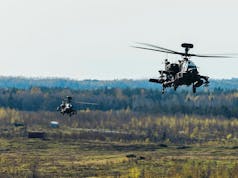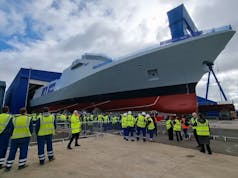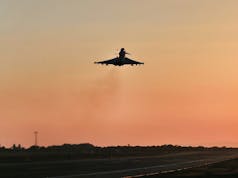Rolls-Royce has completed early engine tests with the F130, the engine which will be offered for the US Air Force B-52 Commercial Engine Replacement Program.
Full-engine tests were completed recently at Rolls-Royce facilities in Indianapolis, US, confirming the engine design and performance are a perfect fit for the B-52 aircraft say Rolls-Royce.
In addition to full-engine tests, Rolls-Royce has already compiled more than 50,000 hours of digital engineering time to further develop and refine the F130 for the B-52.

Adam Riddle, Rolls-Royce, Executive Vice President, Business Development and Future Programs, said:
“The Rolls-Royce F130 engine for the B-52 is part of a proven and efficient family of engines with millions of operational hours. We are excited about our test results in Indianapolis as we continue to demonstrate that the F130 engine is the perfect fit for the B-52. The F130 is the affordable, modern option for this iconic US Air Force aircraft.”
The F130 engine for the B-52, say the firm, produces 17,000 pounds of thrust and is a variant of the Royce BR725 commercial engine.
The F130 series of engines already power aircraft in the US Air Force fleet, including the E-11A and C-37 aircraft, with more than 200,000 hours of combat flight operations.













That doesn’t sound like a particularly powerful engine given that a Trent jet engine can generate 90,000 pounds of thrust so why are they going with such a low power option?
I do assume however that this is much lighter and more fuel efficient that the engines it’s replacing.
I think fuel efficiency would be the key here, as the B-52 will most probably be used to launch long-range weapons at distance on day one of any future conflict in larger numbers than the B2 Spirit for example including LRASM.
I’ve often wondered why the UK has never purchased a handful of these, as we could make very good use of them compared to the cost of a B2.
With potential larger naval forces that we may encounter in future conflicts, serving primarily in an anti-ship role, we could justify spending on the upgraded version at a fraction of the cost of a large surface fleet, including missiles.
https://www.youtube.com/watch?v=h449oIjg2kY
As I thought!
“The aim is to reduce maintenance costs and improve fuel efficiency by at least 20 percent, while maintaining ceiling and takeoff performance.”
https://www.ainonline.com/aviation-news/defense/2019-03-02/new-life-b-52
Many many years ago I thought like a boy, talked like a boy and asked questions like a boy, one of my questions was simple why did the MoD or the RAF not ask for Concord with two drums of eight cruise missiles. Now that would have been a good strike platform.
I seem to remember seeing a drawing of Concorde with some missiles fitted under the wings. Not sure what the missile were though as they were pretty large.
Not sure if Concord could achieve this Ron?
And with more fuel-efficient engines with an increase of up to 20%?
“The bomber is capable of carrying up to 70,000 pounds (32,000 kg) of weapons and has a typical combat range of more than 8,800 miles (14,080 km) without aerial refuelling.”
This is a mans world, or so the song goes!
Concord had a range of 4,889 miles with a B variant for 5,000 miles, Concord when empty was 78,700 kg, gross 111,130 kg and take off weight 185,070kg. If we take the following as an avarage Concord was designed for 100 passangers say at 100 kg each, thats 10,000 kg. Each passanger has 30 kg of baggage 30,000 kg thats 40,000 kg. London Moscow is 1550 miles.
So in theory it could carry two drums of 8 cruise missiles and could fly supersonic London-Moscow and back on a single tank of fuel, its just a big tank.
Also it would not have needed to go all the way as the cruise missile is a stand of missle that could have been launched 700 mles or more from the target. It would not have been any good at dropping conventional bombs. it might have needed to drop out of supersonic flight to launch the cruise missiles.
However as I said this was something I thought about when I was a child, however I still have not seen any argument to say that this was technicaly not possible. If it was at the time it would possibly have been the best strike bomber in the world. Even the Mig 25 would have needed to be up and waiting for it.
Well that was my thinking anyway.
Very interesting Ron, and as you say, an excellent opportunity missed.
I’ve said many times before here that standoff weapons are the best bet for day one scenarios, and with potential problems in the south China sea, we could do with something like the upgraded B52 to deliver a useful anti-ship capability in the numbers required should we need to do so.
MBDA recently announced the development of Spear future deep strike munitions in two variants, 1. Stealth and 2. Speed.
Given our current budget restraints and lack of long-range aerial capability, the enhanced B52 just might fit the bill?
The RAF practically did have a a Concorde like a/c in mind for their fleet in the form of the BAE TS2-R but the project was killed off by the Wilson Labour govt due severe economic issues.
Because there will be a one for one replacement. You don’t need 8 engines at 90,000 lbs each. The airframe couldn’t handle it!. The current engines, TF-33s provide 17,000lbs of thrust at MRT. So the new engines are within the designs specs of the aircraft.
The TF33 provides 17,000 lbs of thrust each at TRT not MRT. Every other point is correct.
It’s not as simple as just sticking another engine to the wing, as much as we (both) wish it were. The engineers need to consider issues with weight distribution, the actual weight the wings can take etc. To do the job, the engines need to be vaguely equivalent to those that are being replaced. a few 100s of kg either way won’t make much of a difference a few 1000s kg will.
Not like the 737 then?
Hi Davey,
Boeing redesigned the 737 wings several generations ago when they switched to the high by-pass engines. The 737 of today is very different to the older models. It made financial sense for them to do so.
I’m sure they could switch to four engines on the B-52 if the money and requirement was there, but it would require a complete redesign of the wing system and with only 75 examples left in service it doesnt seem cost effective.
Shame they forgot to redesign the rest of the 737, perhaps then they would not have had to hack a dangerous design together… And ye the 737 is very different from the originals, however it sill bizarrely flies under the same 1967 certification despite effectively being a completely different aircraft.
As for the B52, I initially wondered why they are still going for 8 engines when 4 larger ones would likely be more efficient and easier to maintain. However I noticed how low the outer engines are to the ground when there is no lift on the wings.
Hi Lee,
I’m not sure I would say the 737 is a “dangerous design”, the 737 has a very good safety record overall, the issues with the 737 MAX are explained here if you’re interested; https://www.youtube.com/watch?v=LQCPSXTE9Mg
Of course, the way Boeing has handled the crisis leaves a lot to be desired.
You’re right about the B-52 wings, the flexibility is what would require the redesign of the entire wing system.
Mr. J. ,
There actually would be some advantage to switching to a 4-engine layout with high-bypass turbofans . Unfortunately , such engines would likely hit the ground , while inducing unacceptable yaw upon the plane .
Ironically, a 2-engine layout with the engines placed close to the fuselage, mitigates these fundamental difficulties . The engines would have to produce 120k.lbs. thrust each , but would definitely increase range/loiter time .
Such a re-engineering would of course , be unjustifiably expensive . 😎
Correct. The original re engining plan first aired back in the 90s was for 4 engines, but that was binned on cost grounds too, although it would have been far cheaper then than now… the inherent changes and rework driven by switching from 8 to 4 were too great, and yes, too expensive.
at a guess i would say that newer style engines with very high bypass ratios aren’t feasible on the b52 as they would be dragging along the ground – so needs to be something smaller to fit
Remember the B-52 has 8 engines.
Just been reading up on this, apparently the USAF had considered a 4 engine reworking for which RR proposed an RB 211 derivative but the wing modifications were considered financially prohibitive. P&W are proposing an upgrade of the present engine but that seems more costly and a less efficient option over the programme life. However there seems to be no actual commitment or budget to actually upgrade the aircraft as yet and this is a proactive proposal based on the sense that it will happen and no doubt encouraging it, by the prospect of new work and investment for its US plants by opening an engine assembly line there for the military version of the engine.
The US Air Force plans to issue an RFP for the B-52 engine replacement by the end of this calendar year with contract award sometime late next year. This has become a very high priority item given the fact that the US has virtually flown the B-1 to death and they have become prohibitively expensive to maintain. In early August, the USAF Chief of Staff reported to Congress that the USAF only had six B-1s able to deploy.The plan is to deactivate the B-1s and B-2s and only maintain the B-52s and B-21s. This engine replacement will get done.
Another problem with 4-engine configurations is loss of an engine on takeoff. With 4 engines you lose 50% of thrust on one side, and the B-52 tail/rudder has insufficient “authority” to correct for that, so you crash. With 8 engines you only lose 25%, which is manageable.
Once upon a time the BUFF had a larger, taller tail, but that had to go when the mission changed from high-altitude to low-medium altitude. It wasn’t needed down there, and it couldn’t take the higher aerodynamic loads, so it was cut down.
They need to keep the same 8 nacelles to sustain flight characteristics and prevent them breaking the wing spars and/or dragging along the tarmac! – so 8 smaller engines rather than 4 large ones.
Performance improvement is likely less important than efficiency and what can be easily fitted onto the pre-existing nacelles with the least engineering and modification. The more different in form the engine is, the more modification to the aircraft is required to fit it, the more approval testing is required, the more expensive it is. The 737Max issues with different engines are a good example of how much of an impact this can have, and how important it is to get right. This is about as close as the US comes to a budget project like the UK does them, so the lower the cost the better.
This article gives some more of the particulars of the USAF’s requirements, it’s likely that the engines chosen tick all of the boxes better than a Trent when considered together. Note, they aren’t looking for an increase in output power of the engine (aside from an onboard generation capability). https://www.thedrive.com/the-war-zone/17121/now-the-air-force-wants-new-engines-for-its-b-52s-that-burn-40-percent-less-fuel
I don’t know if you noticed but the B52 has eight engines, currently being the military version of the PW JT3D, which powered The B707, which is old technology but delivered around 17,500 lbs thrust. Therefore the good old B52 requires small diameter engines, hence RR developing the F130
with the older airframe the f130 engines are just right, don’t want the wings comin’ off. engines more like the orig. ones require less modifications to airframe. also aircraft will fly as the original design, minimizes training for aircrew since the handling / flight envelope remains nearly the same. with these new engines the b52 will enjoy many more years of reliable service, no need for a “new” $$$$ bomber.
The problem with a larger and more powerful engine is that they would have to redesign the wing as well as the nacelle. With these, they only have to modify the engine pods, saving a great deal of money.
My copy of “Nuclear Facts” by Cristy Campbell, 1984, has a photo on page 101 of a B-52, with one pylon trialling a Pratt & Whitney high bypass (for then) engine. One can only imagine how much fuel would have been saved 1984-2019, had the B-52 fleet been re-engine with 4x B-757 engines.
Not enough juice for the squeeze with the additional drag by the larger inlets, also slows the BUFF down, not that it’s a speed demon. While it would provide much more thrust all of that gain would be nullified by having to down-trim the engines due to the airframes not being designed to handle that amount of thrust.
R R a good match proven air time and good service package available, wish the UK had 4 – 6 of these available. A true strike command.
Flightglobal is reporting that the USAF may retire part of its B-1 fleet, to switch the funds to B-21. I would love the RAF to have a single long range bomber sqn with 6-9 2nd hand B-1. Probably cheap to purchase, but expensive to run.
The real beauty of the RR offer is that the USAF is already operating this engine (on their Gulfstream VIP transports).
I think they should go with more thrust for more upgrades!
The BUFF is going to be with us for a LONG time…
https://www.defensenews.com/smr/global-strike/2019/09/16/us-air-force-nears-battle-over-next-b-52-engine/
Cheers!
My dad flew the N52 H models when we were stationed at Homestead AFB Florida. That was during the Cuban missile crises in 62. He died in 2004 at the age of 79. Today he would be in his nineties. This plane needs to be retired ASAP and let’s move on to newer technologies. It’s lived way past it’s time. The only plane I think should deserve it is the B1.
Looks like the B1 is also getting a reprieve.
https://www.defensenews.com/digital-show-dailies/air-force-association/2019/09/17/global-strike-head-makes-case-of-b-1-survival/
Will there still be 8 engines?
With so few B-52 left flying the idea is cost the F130 is Good fit. It can be hung on the existing wing it is a more cost effective operational. A engine with more thrust could require re wotking the wings as would trying a 4 ingine upgrade.
By way of an opposite, check out the ‘re-engined’ 747 at Dunsfold that was used as a film set for Casino Royale. They’ve removed the outer engines, replaced with external fuel tanks, and made the inner pylon into a twin like the B52.
I didn’t know about this when I went, and was thinking ‘what the hell’s going on here’ until I read the info board. It’s quite well done, actually. It convinced me!
SimonJ
Now if Congress would get off their collective duffs and finance the upgrade…